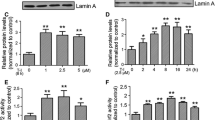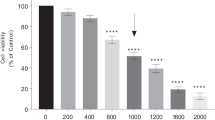Abstract
Hydrogen peroxide (H2O2) is a major Reactive Oxygen Species (ROS), which has been implicated in many neurodegenerative conditions including Parkinson’s disease (PD). Rosmarinus officinalis (R. officinalis) has been reported to have various pharmacological properties including anti-oxidant activity. In this study, we investigated the neuroprotective effects of R. officinalis extract on H2O2-induced apoptosis in human dopaminergic cells, SH-SY5Y. Our results showed that H2O2-induced cytotoxicity in SH-SY5Y cells was suppressed by treatment with R. officinalis. Moreover, R. officinalis was very effective in attenuating the disruption of mitochondrial membrane potential and apoptotic cell death induced by H2O2. R. officinalis extract effectively suppressed the up-regulation of Bax, Bak, Caspase-3 and -9, and down-regulation of Bcl-2. Pretreatment with R. officinalis significantly attenuated the down-regulation of tyrosine hydroxylase (TH), and aromatic amino acid decarboxylase (AADC) gene in SH-SY5Y cells. These findings indicate that R. officinalis is able to protect the neuronal cells against H2O2-induced injury and suggest that R. officinalis might potentially serve as an agent for prevention of several human neurodegenerative diseases caused by oxidative stress and apoptosis.






Similar content being viewed by others
References
Aruoma OI, Bahorun T, Jen LS (2003) Neuroprotection by bioactive components in medicinal and food plant extracts. Mutat Res 544:203–215
Beal MF (2003) Mitochondria, oxidative damage, and inflammation in Parkinson’s disease. Ann N Y Acad Sci 991:120–131
Borner C (2003) The Bcl-2 protein family: sensors and checkpoints for life-or-death decisions. Mol Immunol 39:615–647
Calne DB, Langston JW (1983) Aetiology of Parkinson’s disease. Lancet 2:23–31
Cheung S, Tai J (2007) Anti-proliferative and antioxidant properties of rosemary Rosmarinus officinalis. Oncol Rep 17:1525–1531
Chinnaiyan AM, Orth K, O’Rourke K, Duan H, Poirier GG, Dixit VM (1996) Molecular ordering of the cell death pathway-Bcl-2 and Bcl-x (L) function upstream of ced-3-like apoptotic proteases. J Biol Chem 271:4573–4576
Dawson TM, Dawson VL (2003) Molecular pathways of neurodegeneration in Parkinson’s disease. Science 302:819–822
Greenamyre JT, Sherer TB, Betarbet R, Panov AV (2001) Complex I and Parkinson’s disease. IUBMB Life 52:135–141
Kim SJ, Kim JS, Cho HS, Lee HJ, Kim SY, Kim S, Lee SY, Chun HS (2006) Carnosol a component of rosemary (Rosmarinus officinalis L.) protects nigral dopaminergic neuronal cells. Neuroreport 17:1729–1733
Lee HJ, Cho HS, Park E, Kim S, Lee SY, Kim CS, Kim do K, Kim SJ, Chun HS (2008) Rosmarinic acid protects human dopaminergic neuronal cells against hydrogen peroxide-induced apoptosis. Toxicology 250:109–115
Leung AY, Foster S (1996) Encyclopedia of common natural ingredients used in foods, drugs and cosmetics, 2nd edn. Wiley, New York, pp 446–448
Licker V, Kövari E, Hochstrasser DF, Burkhard PR (2009) Proteomics in human Parkinson’s disease research. J Proteomics 73:10–29
Lo AH, Liang YC, Lin-Shiau SY, Ho CT, Lin JK (2002) Carnosol, an antioxidant in rosemary, suppresses inducible nitric oxide synthase through down-regulating nuclear factor-kappaB in mouse macrophages. Carcinogenesis 23:983–991
Mattson MP, Duan W, Chan SL, Cheng A, Haughey N, Gary DS, Gau Z, Lee J, Furukawa K (2002) Neuroprotective and neurorestorative signal transduction mechanisms in brain aging: modification by genes, diet and behavior. Neurobiol Aging 23:695–705
McCarthy TL, Kerry JP, Kerry JF, Lynch PB, Buckley DJ (2001) Evaluation of the antioxidant potential of natural food/plant extracts as compared with synthetic antioxidants and vitamin E in raw and cooked pork patties. Meat Sci 57:45–52
McNaught KS, Olanow CW (2003) Proteolytic stress: a unifying concept for the etiopathogenesis of Parkinson’s disease. Ann Neurol 53:S73–S84
Orth M, Schapira AH (2002) Mitochondrial involvement in Parkinson’s disease. Neurochem Int 40:533–541
Park JA, Kim S, Lee SY, Kim CS, Kim do K, Kim SJ, Chun HS (2008) Beneficial effects of carnosic acid on dieldrin-induced dopaminergic neuronal cell death. Neuroreport 19:1301–1304
Posadas SJ, Caz V, Largo C, De la Gándara B, Matallanas B, Reglero G, De Miguel E (2009) Protective effect of supercritical fluid rosemary extract, Rosmarinus officinalis, on antioxidants of major organs of aged rats. Exp Gerontol 44:383–389
Prehn JH, Bindokas VP, Jordán J, Galindo MF, Ghadge GD, Roos RP, Boise LH, Thompson CB, Krajewski S, Reed JC, Miller RJ (1996) Protective effect of transforming growth factor-beta 1 on beta-amyloid neurotoxicity in rat hippocampal neurons. Mol Pharmacol 49:319–328
Sayre LM, Perry G, Smith MA (2008) Oxidative stress and neurotoxicity. Chem Res Toxicol 21:172–188
Schapira AH (1999) Science, medicine, and the future: Parkinson’s disease. BMJ 318:311–314
Shibata N, Kobayashi M (2008) The role for oxidative stress in neurodegenerative diseases. Brain Nerve 60:157–170
Yuan H, Zheng JC, Liu P, Zhang SF, Xu JY, Bai LM (2007) Pathogenesis of Parkinson’s disease: oxidative stress, environmental impact factors and inflammatory processes. Neurosci Bull 23:125–130
Zhang Y, Dawson VL, Dawson TM (2000) Oxidative stress and genetics in the pathogenesis of Parkinson’s disease. Neurobiol Dis 7:240–250
Ziv I, Melamed E, Nardi N (1998) Role of apoptosis in the pathogenesis of Parkinson’s disease: a novel therapeutic opportunity. Mov Disord 13:865–870
Acknowledgments
This study was supported by research funds from Chosun University, 2008, Korea.
Author information
Authors and Affiliations
Corresponding author
Rights and permissions
About this article
Cite this article
Park, SE., Kim, S., Sapkota, K. et al. Neuroprotective Effect of Rosmarinus officinalis Extract on Human Dopaminergic Cell line, SH-SY5Y. Cell Mol Neurobiol 30, 759–767 (2010). https://doi.org/10.1007/s10571-010-9502-3
Received:
Accepted:
Published:
Issue Date:
DOI: https://doi.org/10.1007/s10571-010-9502-3




